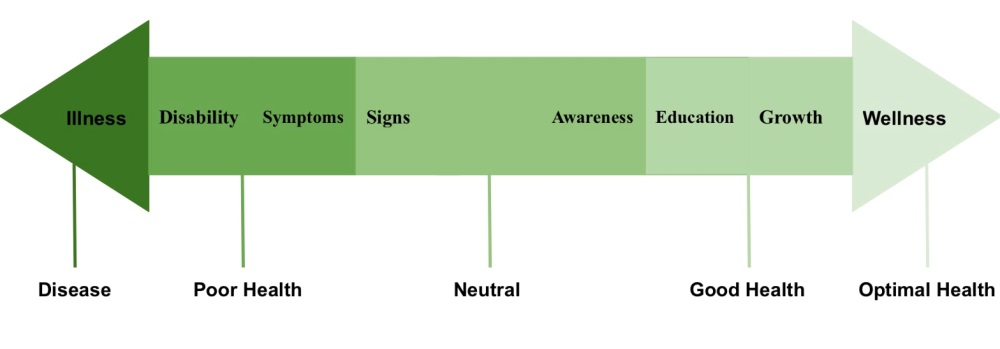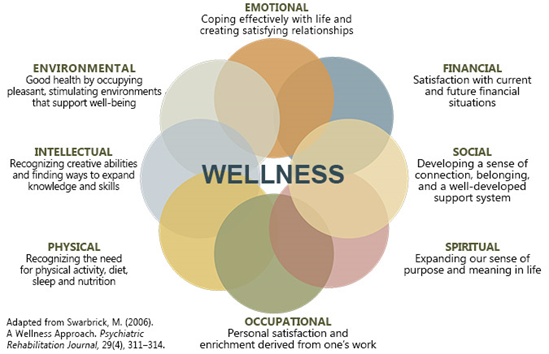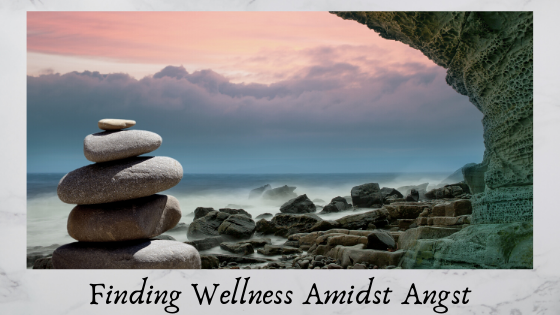The following article was written by Kelsy Vick, SPT, who recently finished her final doctoral student physical therapy residency with Symmetry. Our whole staff extends our best wishes to Kelsy for her upcoming graduation and the launch of a promising professional career!
When you think of the word “health”, what comes to mind? You might be recalling the salad you had for lunch, going for a run or a walk after work, or the physical therapy appointments you have been attending. As a future physical therapist, my first thought about the word “health” naturally revolves around a person’s physical health. Now think about the word “wellness”. What comes to mind? Some may start to think of a broader state of health, with thoughts about psychosocial wellbeing, meditation, or general self-care. The World Health Organization defines health as “the state of complete physical, mental, and social wellbeing and not merely the absence of disease or infirmity”1. Wellness can be defined as “the holistic integration of physical, mental, and spiritual well-being, fueling the body, engaging the mind, and nurturing the spirit”2. Dr. John Travis – an American physician and author – conceptualized wellness by creating an Illness-Wellness Continuum in 1972. In his work he presents wellness as a continually fluctuating process of awareness, change, and growth between overall wellness and disease3.

Wellness can also be separated into 8 different dimensions: emotional, environmental, financial, social, spiritual, occupational/vocational, physical, and intellectual. Many individuals are accustomed to regularly tending to at least several of these dimensions. Other areas may be less often considered. In theory, working to develop balance between each of the different aspects of this wellness schematic yields optimal physical and mental health.

So, why the focus on health and wellness? I think in a time where words like quarantine and social distancing are utilized in everyday (read: hourly) conversation, it is important for all of us to take this as an opportunity to develop those aspects of wellness that we may have neglected – due to work or other obligations. My goal is to educate patients and the community about the different domains of wellness in order to offer an opportunity for self-reflection and growth during this time of uncertainty. Here are some of the things that we can be working on in order to maintain or cultivate wellness in the various dimensions described in the graphic above:
Physical Dimension2
- Caring for your body to stay healthy now and in the future. This might mean establishing a new routine of walking with your family and/or pets, or perfecting some new healthy recipes. It could also mean working on improving restful sleep or on supporting natural wake-sleep cycles by making sure to have exposure to plenty of natural daylight each day.
Intellectual Dimension2
- Growing intellectually, maintaining curiosity about all there is to learn. Expanding skills while discovering the potential for sharing your gifts with others. This might be a good time to take a class on line, to learn a new language via a mobile phone app, or to delve into some reading about a topic that you’ve always been curious about but never had the time to research. Then consider sharing new knowledge gained through individual efforts with a collective – perhaps via a book club group or as an on-line volunteer with the school system.
Emotional Dimension2
- Understanding and respecting your feelings, values, and attitudes, as well as those of others. Making efforts to feel positive and enthusiastic about your life. We are all in this pandemic situation together – across the country and across the globe. Our ability to be compassionate and empathetic as we individually and collectively strive to adjust and navigate through the next weeks and months will be essential. As a starting point to improve positivity in your own life and in those of others, check out this blog post entitled 25 Ways to Feel Happier in the Next 5 Minutes.
Social Dimension2
- Maintaining healthy relationships, developing friendships and intimate relations, caring about others, and letting others care about you. Contributing to your community. The oft-repeated “social distancing” call to action really would be more accurate if described as “physical distancing”. Check out this article that explains the toxic effects that isolation can produce, and which also gives suggestions about how we can continue to cultivate a strong community even as we are maintaining space between us.
Spiritual Dimension2
- Finding purpose, value, and meaning in your life. Participating in activities that are consistent with your beliefs and values. A sense of connection, fulfillment and sacredness is important – whether that be associated with organized religion, or nature, or a higher sense of individual self. This post from The Chopra Center offers some tips for spiritual self-care.
Vocational/Occupational Dimension2
- Contributing your unique gifts, skills, and talents to work that is personally meaningful and rewarding. The Health Sciences Department at Washington State University in Spokane suggests these tips for improving occupational wellness:
- Don’t settle, keep motivated and work towards what you want.
- Increase your knowledge and skills to accomplish your goals.
- Find the benefits and positives in your current job.
- Create connections with co-workers.
- Write out goals, create a plan to execute them, and then start working on your plan.
- Look for something new and/or talk to a career counselor if you feel the need to make a change.
Financial Dimension2
- Being aware that everyone’s financial values, needs, and circumstances are unique. There are countless strategies for investment and financial planning – each of which may or may not be applicable for any one person or family. Regardless of any individual situation, tending this dimension of wellness involves managing resources, making informed financial decisions, setting realistic goals, and preparing for short-term and long-term needs.
Environmental Dimension2
- Understanding how your social, natural, and built environments affect your health and well-being.
We are all currently confronted with an acute awareness of the unstable state of the earth and the effects that our individual daily habits may have on the physical environment. Our collective societal efforts to manage our current public health challenges demonstrate commitment to a healthy human society and a healthy planet.
In summary, despite what comes to mind with words like health and wellness, I think it is important for us in this time of angst to focus our attempts on improving the domains of wellness that we may forget about from time-to-time. We are all affected by COVID-19 and are undoubtedly feeling a lack of control in one way or another. Perhaps we can attempt to take the reins on things over which we do have control and use this time to work to improve our overall wellness for the long run.
References:
- WHO. Constitution. World Health Organization. Accessed March 18, 2020. https://www.who.int/about/who-we-are/constitution
- Stoewen, D. Dimensions of wellness: change your habits, change your life. Can Vet J. 2017 Aug; 58(8): 861–862. https://www.ncbi.nlm.nih.gov/pmc/articles/PMC5508938/. Accessed March 18, 2020.
- Setting straight the historical record re the Travis illness-wellness continuum. E-AWR. 2013;(641):2. Accessed March 18, 2020.
Picture References:
- Adapted from: https://www.wellpeople.com/WhatIsWellness.aspx. Accessed March 18, 2020.
- Boston University College of Health and Rehabilitation Sciences: Sargent College. Eight dimensions of wellness. BU center for psychiatric rehab. https://cpr.bu.edu/app/uploads/2012/01/eight-dimensions-wellness1.jpg. Accessed March 18, 2020.

